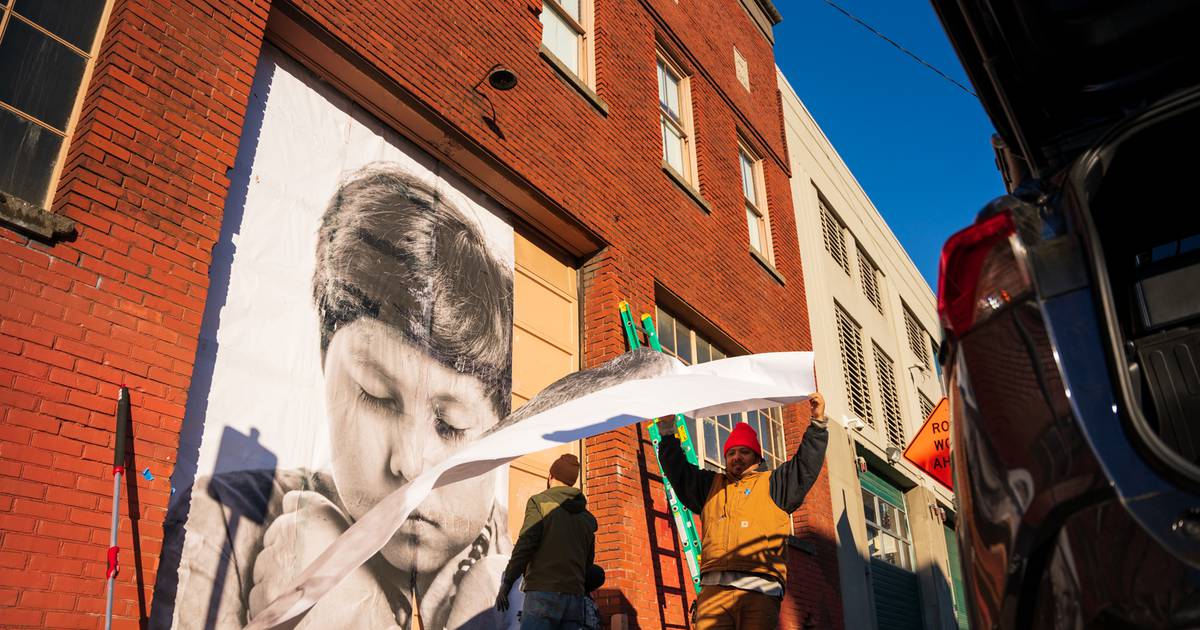
Visitors to the Center for Native Arts and Cultures in Southeast Portland heard water trickling while taking in artist Marie Watt’s compelling sculpture on exhibit this month. The sound was live, captured by a microphone in the center’s basement where a thin tributary of the Columbia River flows. The soothing noise was then transmitted through speakers in the first-floor gallery.
The art, the water and the site are significant. Centuries before the center’s newly acquired brick building was constructed in 1908, people hunted and fished, traded goods and built community here.
Watt, a member of the Seneca Nation of Indians who lives in Portland, said her billboard-sized sculpture, “Chords to Other Chords (Relative),” is a conversation connecting ancestors and future generations to the land. The words “Turtle Island And,” referencing the creation story of North America, are seen in neon among images of Indigenous people and treaty documents.
HERE IS OREGON: HereisOregon.com | Instagram | YouTube | Facebook | Twitter | TikTok
“Our present moment is inextricably tethered to the communities of past and future,” Watt said in a news release about the exhibit that ran Aug. 24-Oct. 13.
It is also significant that Watt’s art, inspired by Seneca oral history traditions and since acquired by collector Jordan Schnitzer, was “not siloed in an inaccessible space,” continued the news release. Instead, the exhibit was free and open to the public in a repatriated building that is the 14-year-old Native Arts and Cultures Foundation’s first permanent home.
The land and building transfer of ownership by the nonprofit Yale Union contemporary arts organization took place in 2020, and has inspired others, seeking restorative social change and guided by the Land Back Movement, to return property to Indigenous stewardship and ownership.
The Native Arts and Cultures Foundation, supported by donations of tribal partners, is dedicated to advancing equity and Native knowledge with a focus on arts and cultural expression.
Since the national nonprofit organization was founded in Portland in 2009, it has awarded more than $14 million in program services to Native organizations and has helped advance the careers of nearly 400 American Indian, Native Hawaiian and Alaska Native artists and culture bearers across the U.S.
With its headquarters and event center at 800 S.E. 10th Ave. off Southeast Belmont Street, the foundation can also provide space for curated Native art exhibitions, cultural ceremonies and celebrations, said foundation spokeswoman Mandy Yeahpau.
On July 29, the center presented an art project by one of its grant recipients, Lehuauakea, a mahu mixed-Native Hawaiian artist who creates traditional Native Hawaiian kapa (barkcloth) kites, called lupe. The art is titled “E Hoʻala Ka Lupe: To Awaken the Kite.”
The event also offered entertainment by the KALO Hawaiian Civic Club and goods for sale by Koa Roots, Pa’akai Shop, Honu Hawaiian Shave Ice and other local makers.
The organization, led by founding president and chief executive officer Lulani Arquette, who is Native Hawaiian, also opens its three-level Portland building to free community tours to meet Native makers from 6 to 8 p.m. one Thursday each month.
At September’s community tour, Portland chef and artist Ramon Shiloh, who is Mvskoke, Cherokee, Filipino and Black, spoke about First Nations Foods, foraging seasonal ingredients, food sovereignty and Indigenous food knowledge. Shiloh made six naturally gluten-free dishes, including smoked sockeye salmon patties with freshly harvested Chippewa wild rice and salmon roe.
The tours are free and visitors are asked to register in advance at nativeartsandcultures.org/events/communitytours.
Upcoming events are:
- Oct. 26′s community tour includes a screening of “Rid,” a horror, revenge short film about abusers preying on Indigenous community members by filmmaker Olivia Camfield, a member of the Muscogee Creek Nation. The multimedia movement artist, who was awarded a 2022 LIFT grant by the Native Arts and Cultures Foundation, will be there to answer questions.
- Nov. 16′s community tour includes storytelling with Lillian Pitt, a Pacific Northwest creator of contemporary fine art that honors the history and legends of her ancestors living in the Columbia River Gorge area.
- Dec. 7′s community tour will have Indigenous makers selling their work at a pop-up holiday market.
Yeahpau, who is Comanche, Cherokee and Tarahumara, and other staff members lead visitors on a tour of the building, using the freight elevator to move from the black-box theater space on the first floor to the second-story event space surrounded by tall arched windows.
“People are happy that we’re creating space for art in a time when many organization have decreased programing” due to a fall in art funding, Yeahpau said. “It gives people hope that there is support for art in Portland, especially Indigenous art.”
Fundraising will help renovate and add ADA-accessible features and air conditioning to the 115-year-old former Yale Union Laundry Building. The 40,000-square-foot masonry structure, designed with an Italian Renaissance style exterior and Egyptian Revival style ornamentation, earned a listing on the National Register of Historic Places since it represents Portland’s once robust industrial laundry business.
The building also played a role in 1919 when laundry workers, mostly women, went on a strike that resulted in better pay and working conditions.
Improvement plans also include creating an area near the creek-fed water table visible in the excavated basement for visitors to connect with the past and reflect on the importance of water.
“The gift of this historic building has been a powerful validation of our work with Native peoples and communities,” said Arquette. “We are humbled and grateful to learn the importance of co-caring for physical property in an urban area that is on the original lands of tribal peoples that have resided here since time immemorial.”
— Janet Eastman | 503-294-4072
[email protected] | @janeteastman
